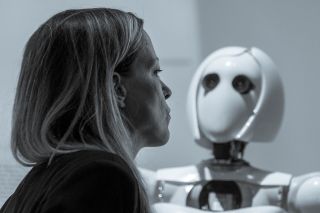Artificial Intelligence
Enter Robots: Are We Ready?
Humanoid robots are on the horizon. Will they change our ideas of personhood?
Posted April 25, 2024 Reviewed by Ray Parker
Key points
- Robots are poised to have a dramatic impact on our lives.
- From robotic limbs to bionic eyes and ears, human cyborgs are emerging.
- Humanoid robots are the next step in robotic evolution.

The term “robot” suggests a human-like machine—a walking, talking automaton. Robotics is a much broader technology: Assembly robots in factories, warehouse workers, or surgical robots in operating rooms do not look like humans at all.
One of the most interesting new uses of robotics aren’t in full humanoid form at all but are replacing parts of humans. For example, robotic prostheses attached as substitute limbs can grant new mobility and agency to amputee patients. The newest artificial limbs have real-time neural controls and tactile feedback, allowing for more natural motion and touch.
Beyond robotic limbs is the development of sensory robotics: an artificial retina/eye allowing the blind to see again or an artificial cochlea to grant hearing to the deaf (1,2). Add the newest “brain-computer interface” technology (3), and the potential for robot prostheses to improve dramatically the lives of people with disabilities cannot be understated.
A digital retina, an artificial cochlea, robotic limbs, or, within a few years, a fully artificial heart or kidney (4,5,6) are considered “bionic” parts. Eventually, the brain-computer interface (BCI) will give patients increasing control of these bionic parts. Self-contained power sources, combined with artificial intelligence (AI), will make future prostheses more agile, powerful, and responsive. Perhaps someday, a person with enough hardware attached will be considered a super-cyborg.
Beyond replacing body parts, perhaps the most exciting next step will be the development of humanoid robots to serve as coworkers, assistants, and caregivers. Humanoid robots will soon show up in medical settings to take vital signs and assist with patient care. Humanoid robots will permeate the workplace and around the house, doing everything from housekeeping to gardening to shopping. Humanoid robots will soon be among us in our daily lives. How will we treat these robot helpers?
Other innovations predicted to become mainstream soon include:
- A digital radar cane to help the blind navigate.
- A cyber-limb that is agile, powerfully strong, and responds to both muscle and brain commands.
- A digital retina/eye directly connected to the optic nerve/brain to provide unsighted persons with vision (and zoom-enhanced).
- Next-generation robot workers that will not only carry, move, and lift objects, but whose AI will allow them robots to learn and perform simple tasks, use tools, and even know when to ask a human for help.
A Brookings survey (7) predicts we’ll see significant entry of robots into our lives within 10 years. Entrepreneur Elon Musk, on social media, forecasts that over 1 billion human-like robots will "live" among us by 2040. As driverless vehicles hit the road, so too will robotic athletic trainers, medical assistants, house robots, companions, police, soldiers, and babysitters. Humanoid robots are already being developed to roll off the assembly lines in the near future. (8)
Are we ready for this social evolution? Will we trust our AI-enhanced humanoid robots to care for loved ones? How will we respond to humanoid robots: as valued helpers or as servants? Would humans resent these humanoid robotic competitors if they took over some jobs? We may wish to consider these questions now before we live with billions of humanoid robots.
To fully trust future robots, perhaps we must teach them laws, rules, values, and ethics—for example, Isaac Asimov's First Law of Robotics: “A robot may not injure a human being or, through inaction, allow a human being to come to harm.”
Having anthropoid robots operating all around us is no longer a matter of “if,” just a matter of when. We may have to get used to the idea of robots among us. Will we program these robots to reflect our values and biases so they reflect their makers? Human-like robots may challenge our understanding of “personhood.” Science fiction, from Asimov’s I, Robot to the android named Data from Star Trek: The Next Generation, raises the question: “Are these people?” Beyond intelligence and moving around, what really is "personhood?" Perhaps it’s the capacity to decide, choose, and exercise free will. Humanoid robots are coming, and with the explosion of AI, they may be a lot like us. How will we collectively treat them?
“In the twenty-first century, the robot will take the place [of] slave labor.” —Nikola Tesla
References


